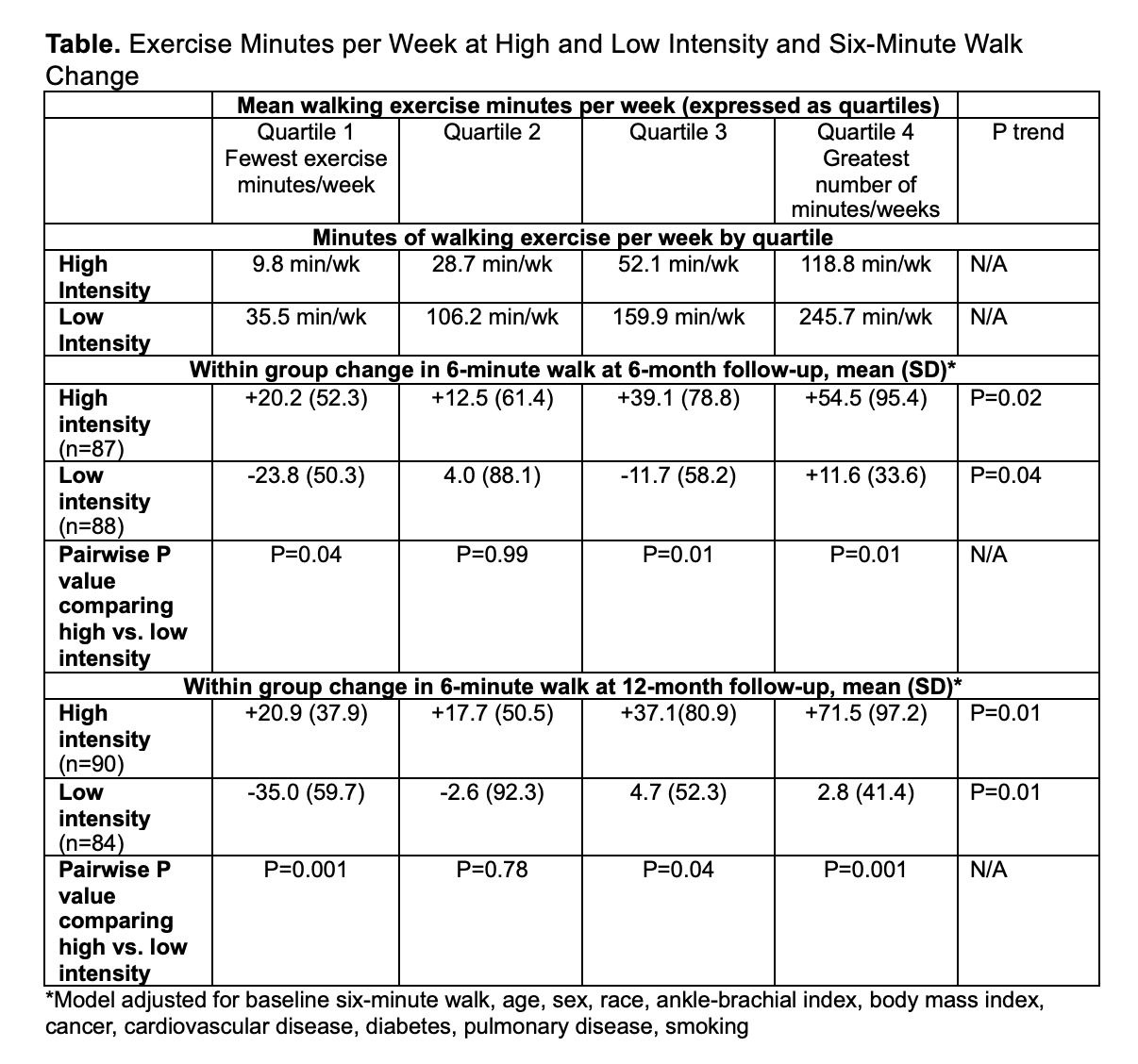Final ID: MDP151
High-Intensity Walking Exercise Minutes and Improved Walking Performance in Peripheral Artery Disease: LITE Randomized Clinical Trial
Abstract Body (Do not enter title and authors here): Background: The LITE randomized clinical trial evaluated the effect of high-intensity vs low-intensity walking exercise on walking ability for peripheral artery disease (PAD). In post-hoc analyses, this study evaluated whether people with PAD who walked more exercise minutes per week had greater six-minute walk (6MW) improvement, compared to those who walked fewer exercise minutes per week. Within each quartile of exercise minutes, change in 6MW was compared between high and low-intensity exercise groups.
Methods: People with PAD were randomized to walking exercise that induced ischemic leg symptoms (high-intensity), walking exercise at a comfortable pace without ischemic leg symptoms (low-intensity), or a control group that did not exercise for 12 months. Participants randomized to exercise were asked to walk 5 days/week up to 50 minutes/day. High-intensity exercise was defined and objectively measured using an ActiGraph. Participants wore an ActiGraph during exercise to measure exercise minutes/week. The primary outcome was 12-month change in 6MW.
Results: Of 305 PAD participants randomized (47% women, 59% Black), 208 were assigned to exercise and had data available for analyses. The high-intensity exercise group walked fewer exercise minutes/week than the low-intensity exercise group (51.95 vs 136.82, P< 0.0001). In each exercise group, greater exercise minutes/week at target intensity were associated with greater 6MW improvement (Table). Within each quartile of exercise minutes/week, high-intensity exercise improved 6MW significantly more than low-intensity (Table).
Conclusion: In the LITE randomized trial, among people randomized to high-intensity and low-intensity exercise, respectively, more minutes of exercise per week were associated with greater 6MW improvement. However, within each quartile of exercise minutes/week, high-intensity exercise improved 6MW significantly more than low-intensity exercise.
Methods: People with PAD were randomized to walking exercise that induced ischemic leg symptoms (high-intensity), walking exercise at a comfortable pace without ischemic leg symptoms (low-intensity), or a control group that did not exercise for 12 months. Participants randomized to exercise were asked to walk 5 days/week up to 50 minutes/day. High-intensity exercise was defined and objectively measured using an ActiGraph. Participants wore an ActiGraph during exercise to measure exercise minutes/week. The primary outcome was 12-month change in 6MW.
Results: Of 305 PAD participants randomized (47% women, 59% Black), 208 were assigned to exercise and had data available for analyses. The high-intensity exercise group walked fewer exercise minutes/week than the low-intensity exercise group (51.95 vs 136.82, P< 0.0001). In each exercise group, greater exercise minutes/week at target intensity were associated with greater 6MW improvement (Table). Within each quartile of exercise minutes/week, high-intensity exercise improved 6MW significantly more than low-intensity (Table).
Conclusion: In the LITE randomized trial, among people randomized to high-intensity and low-intensity exercise, respectively, more minutes of exercise per week were associated with greater 6MW improvement. However, within each quartile of exercise minutes/week, high-intensity exercise improved 6MW significantly more than low-intensity exercise.
More abstracts on this topic:
Analysis of Near-Infrared Spectroscopy Vascular Occlusion Test as a Complement to Ankle-Brachial Index and 6-Minute Walk Test in Patients Diagnosed with Peripheral Artery Disease
Rodriguez Cesar, Lanka Santh Prakash, Maraj Joshua, Alsabbagh Yaman, Farres Sam, Ade Carl, Liu Xiuwen, Delp Judy
Angiotensin Converting Enzyme Gene Polymorphisms (ACE-I/D) Do Not Predict Exercise-Induced Cardiac Remodeling or Performance in Adolescent Male AthletesBecker Kristian, Hardie William, Gubanich Paul, Hill Garick, Logan Kelsey, Martin Lisa, Powell Adam

